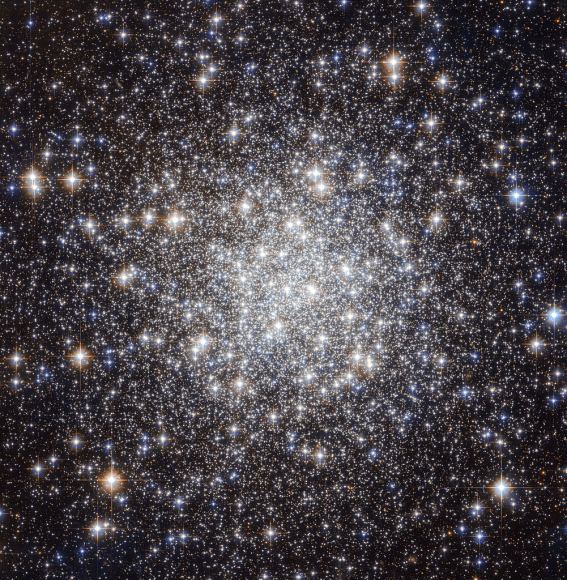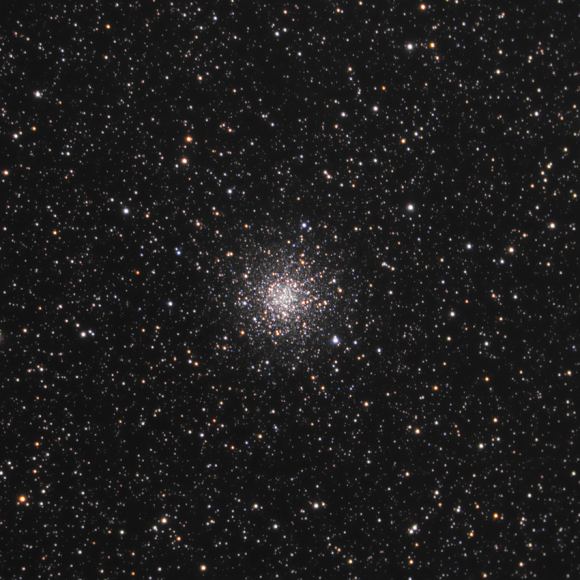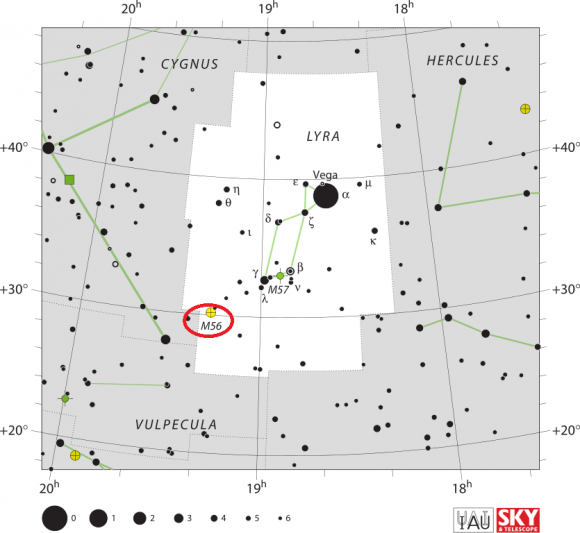Welcome back to Messier Monday! We continue our tribute to our dear friend, Tammy Plotner, by looking at the the globular star cluster known as Messier 56. Enjoy!
In the 18th century, while searching the night sky for comets, French astronomer Charles Messier kept noting the presence of fixed, diffuse objects in the night sky. In time, he would come to compile a list of approximately 100 of these objects, with the purpose of making sure that astronomers did not mistake them for comets. However, this list – known as the Messier Catalog – would go on to serve a more important function.
One of these objects is Messier 56, a globular star cluster located in the small northern constellation of Lyra, roughly 32,900 light years from Earth. Measuring roughly 84 light-years in diameter, this cluster has an estimated age of 13.70 billion years. It is also relatively easy to spot because of its proximity to well-known asterisms like the celestial Swan, the Northern Cross, and the bright star Vega.
Description:
Spanning about 85 light years in diameter, this incredible ball of stars is moving towards planet Earth at a speed of 145 kilometers per second… yet still remains about 32,900 light-years away. As one of the less dense of the Milky Way’s halo globulars, it is also less dense in variable stars – containing only perhaps a dozen. But out of that twelve, there a very special one… a Cepheid bright enough to be followed with amateur instruments. However, astronomers never stopped looking for the curious – and they found what they were looking for!

The CURiuos Variables Experiment (CURVE) was performed on M56 in 2008. As P. Pietrukowicz (et al) wrote of the cluster in the accompanying study:
“We surveyed a 6.5’×6.5′ field centered on the globular cluster M56 (NGC 6779) in a search for variable stars detecting seven variables, among which two objects are new identifications. One of the new variables is an RRLyrae star, the third star of that type in M56. Comparison of the new observations and old photometric data for an RV Tauri variable V6 indicates a likely period change in the star. Its slow and negative rate of -0.005±0.003 d/yr would disagree with post-AGB evolution, however this could be a result of blue-loop evolution and/or random fluctuations of the period.”
But could other things exist inside M56? Events, perhaps, like nova? As astronomer Tim O’Brien wrote:
“Classical nova outbursts are the result of thermonuclear explosions on the surface of a white dwarf star in a close binary system. Material from the other star in the system (one not unlike our own sun) falls onto the surface of the white dwarf over thousands of years. The pressure at the base of this layer of accreted material builds up until thermonuclear reactions begin explosively. An Earth’s mass or more of material is ejected from the surface of the white dwarf at speeds of a few hundred to a few thousand kilometres per second. Old novae are therefore surrounded by shells of ejected matter illuminated by the light from the central binary system.”
And as M.E.L. Hopwood (et al.) wrote in a 2000 study:
“We report the possible detection of diffuse X-ray emission in the environment of NGC 6779, and find the emission to be well aligned with the proper motion of the cluster. The position of the emission suggests we are observing heated ISM in the wake of the cluster that could be the result of an interaction between the intracluster medium and the halo gas surrounding it.”

History of Observation:
Charles Messier first discovered M56 on January 23rd, 1779. As he wrote of his discovery at the time:
“Nebula without stars, having little light; M. Messier discovered it on the same day as he found the comet of 1779, January 19. On the 23rd, he determined its position by comparing it with the star 2 Cygni, according to Flamsteed: it is near the Milky Way; and close to it is a star of 10th magnitude. M. Messier reported it on the chart of the comet of 1779.”
However, it would be Sir William Herschel who revealed its true nature in 1807. In his private notes he writes: “The 56th of the Connoiss. is a globular cluster of very compressed and very small stars. They are gradually more compressed towards the centre.” His son John would go on to observe it many times, even after cataloging it! His best description reads: “Large; round; very gradually brighter toward the middle. I see the stars which are very small and of different sizes. It fades gradually away to the borders.”
As always, it would be Admiral Smyth who would be perhaps a bit more descriptive when he included in his observing notes:
“A globular cluster, in a splendid field, between the eastern joke of Lyra’s frame and the Swan’s head: it is 5 1/4 deg distant from Beta Lyrae, on the south-east line leading to Beta Cygni, which is about 3 1/2 deg further. This object was first registered by M. Messier in 1778, and, from his imperfect means, described as a nebula of feeble light, without a star. In 1784, it was resolved by Sir William Herschel, who, on gauging, considered its profundity to be of the 344th order.”

Locating Messier 56:
Finding M56 isn’t too hard since it’s located about half-way between Beta Cygni (Albireo) and Gamma Lyrae. In both binoculars and finder scope, you will see a triangle of stars when progressing from Gamma towards the southeast that will almost point directly at it! Because M56 isn’t particularly large or bright, it does require dark skies – but makes a great object for both binoculars and small telescopes.
Enjoy this pincushion of stars! And here are the quick facts on this Messier Object to help you get started”
Object Name: Messier 56
Alternative Designations: M56, NGC 6779
Object Type: Class X Globular Cluster
Constellation: Lyra
Right Ascension: 19 : 16.6 (h:m)
Declination: +30 : 11 (deg:m)
Distance: 32.9 (kly)
Visual Brightness: 8.3 (mag)
Apparent Dimension: 8.8 (arc min)
We have written many interesting articles about Messier Objects here at Universe Today. Here’s Tammy Plotner’s Introduction to the Messier Objects, M1 – The Crab Nebula, and David Dickison’s articles on the 2013 and 2014 Messier Marathons.
Be to sure to check out our complete Messier Catalog. And for more information, check out the SEDS Messier Database.
Sources:

